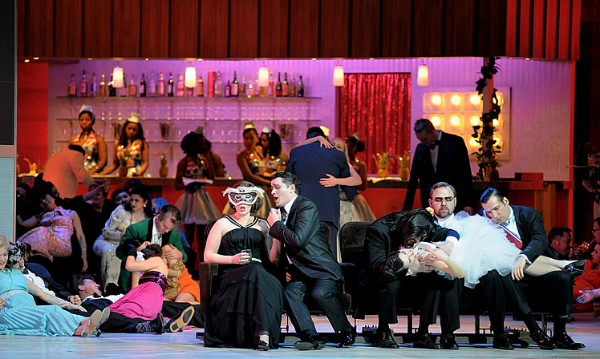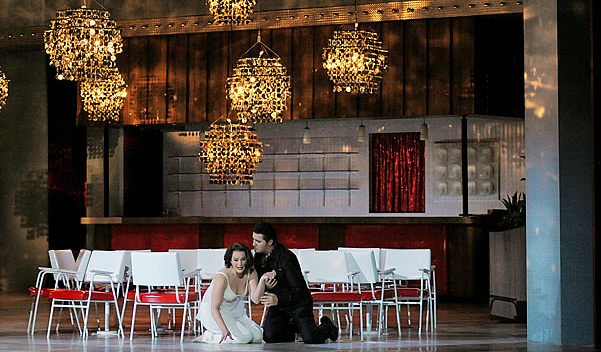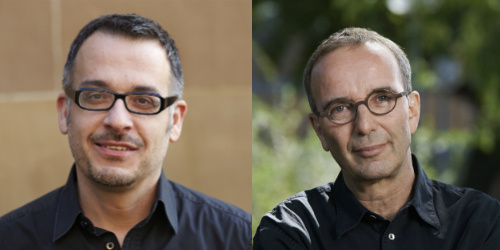-
10 Things to Know about Verdi's A Masked Ball
By Danielle D'OrnellasPosted in A Masked BallBy Nikita Gourski, Development Communications Coordinator, and Gianmarco Segato, Adult Programs Manager

Need a quick refresher about Verdi's A Masked Ball (Un ballo in maschera) before you attend your performance? Look no further! Here are the top ten things you need to know about this opera, and our production.
1. MAKING THE OLD NEW
It was the first and only time in Verdi’s career that he adapted an already existing libretto, Gustave III, ou Le bal masqué by Eugène Scribe. Scribe’s libretto had been set to music by French composer Daniel Auber in 1833 and enjoyed great success at its premiere in Paris.2. A HISTORICAL OPERA
The libretto was based on the 1792 assassination of the progressive and widely adored King Gustav III of Sweden. Gustav was shot at a masked ball in Stockholm and died several days later.3. STOCKHOLM TO BOSTON
As Verdi worked on the opera with his translator and librettist, Antonio Somma, the royal censors in Naples demanded a number of changes. The opera went through three different titles, and just as many historical periods and locations (18th-century Stockholm, 17th-century Pomerania, 14th-century Florence), before ending up at the centre of a legal dispute between Verdi and the management of the Teatro San Carlo. The courts released Verdi from his contract in Naples, and the composer took his opera to another theatre in Rome. There, the original Swedish setting was also rejected, but Verdi proposed 17th-century Boston as an alternative, with a governor instead of a king, which satisfied all parties involved. It was in this version that A Masked Ball finally premiered in Rome in 1859. The Boston setting was the standard version throughout Europe in Verdi's life-time, though within two years of the opera's premiere, a production in Paris had set the action in Italy.4. EXTERNAL DETAILS WEREN'T OF CRITICAL IMPORTANCE
The opera's genesis shows that what was critical for Verdi in Masked Ball was not so much the outer detail — a particular city or a nobleman's rank — but the universal structures that govern our most private and public relationships.
5. A COMPLEX LOVE TRIANGLE
A Masked Ball marked Verdi’s move away from melodrama toward subjects of greater emotional complexity. The characters here are multi-faceted, experiencing intense conflicts of the heart and mind. The Governor Riccardo is in love with his best friend’s wife, Amelia, but realizes that unchecked ardour would only compromise her marriage and lead to misery. Similarly, Amelia feels real passion for Riccardo but can’t bring herself to betray her husband Renato. Meanwhile Renato – probably the most complex baritone part Verdi ever wrote – is devastated when he discovers what appears to be an affair between Amelia and Riccardo, the man he has sworn to protect with his life against a brewing conspiracy. Remarkably, Renato never turns into a one-dimensional villain and Verdi gives him a broad spectrum of conflicting emotions, from vengeful bloodlust, to grief at the breakdown of his marriage, and from pain at being betrayed to sorrow at the loss of a friend he loved and admired.6. BLENDING COMEDY AND TRAGEDY
This opera is Verdi’s most successful fusion of light and dark styles. The commingling of tragedy and comedy is most striking during the opera’s final scene when the stage band at the masked ball, apparently unaware that the Governor has been shot, continues to play upbeat dance music while Riccardo succumbs to his wounds.7. VERDI LOOKS TO FRENCH MODELS
In composing to a French libretto, Verdi opted to use musical forms associated with 19th-century French opera. This is especially true of the music he wrote for the page Oscar, who often sings in straight-forward French couplets (two-versed songs) that lighten the mood with fun and mischief. The part of Oscar is traditionally performed as a pants role (a male character played by a female singer), but in this production Oscar’s character is presented as a young woman.8. A MODERN AMERICAN SETTING
This production takes place in an America of the 50s and 60s, but makes references to symbols and iconography outside that epoch – for example the extravagant outfit Oscar wears to the masked ball is a theatrical wink citing Björk’s “swan dress” at the 2001 Oscars. In drawing from a broad spectrum of real and mythic American tropes, this production presents a completely invented “modern America,” reinforcing Verdi’s artistic recommendation that “to copy reality can be a good thing, but to invent reality is much, much better.”9. A VERSATILE HOTEL
The set is a hotel ballroom that can transform seamlessly into different locales of the opera. During Act II, for example, when Amelia is in a cemetery by the gallows, the lighting dims, the columns of the ballroom suddenly become transparent to reveal vine-like plants crawling upward, and chandeliers lower to create the illusion of treetops that rustle and sway in the wind. The single set complements the action of A Masked Ball, one of Verdi’s most compact and propulsive operas.
10. A RENOWNED DIRECTORIAL TEAM
Two-time winners of the “Directorial Team of the Year” recognition (2002 and 2012), selected by an international panel of 50 critics contributing to the magazine Opernwelt, Jossi Wieler and Sergio Morabito have also been the recipients of “Der Faust” – a major German theatre award – for best opera staging (2006 and 2012). They are renowned for immersing themselves deeply in the score and following the nexus of text and music to arrive at their production’s aesthetic and thematic focus. When Jossi Wieler was recently appointed head of the Stuttgart Opera, the Financial Times noted that it meant a welcome return to “productions based firmly on score and text” and praised him and Morabito for their “unshakeable faith in the score.” When it premiered in 2008, this production of A Masked Ball was hailed by Bloomberg for being “unashamedly entertaining” and having the “cinematic dynamism and the velocity of a good thriller.”A Masked Ball runs from February 2 to February 22 at the Four Seasons Centre for the Performing Arts. To learn more and to purchase tickets, click here.
Photos: (top) Catherine Naglestad as Amelia and Piotr Beczala as Riccardo in the Berlin Staatsoper production of Un ballo in maschera, 2008. Photo by Ruth Walz; (middle) (l – r) Catherine Naglestad as Amelia, Piotr Beczala as Riccardo, Dalibor Jenis as Renato, Anna Prohaska as Oscar, Oliver Zwarg as Samuel and Andreas Bauer as Tom in the Berlin Staatsoper production of Un ballo in maschera, 2008. Photo by Ruth Walz; (bottom) Sergio Morabito. Photo by A.T. Schaefer & Jossi Wieler Photo by Martin Sigmund.
